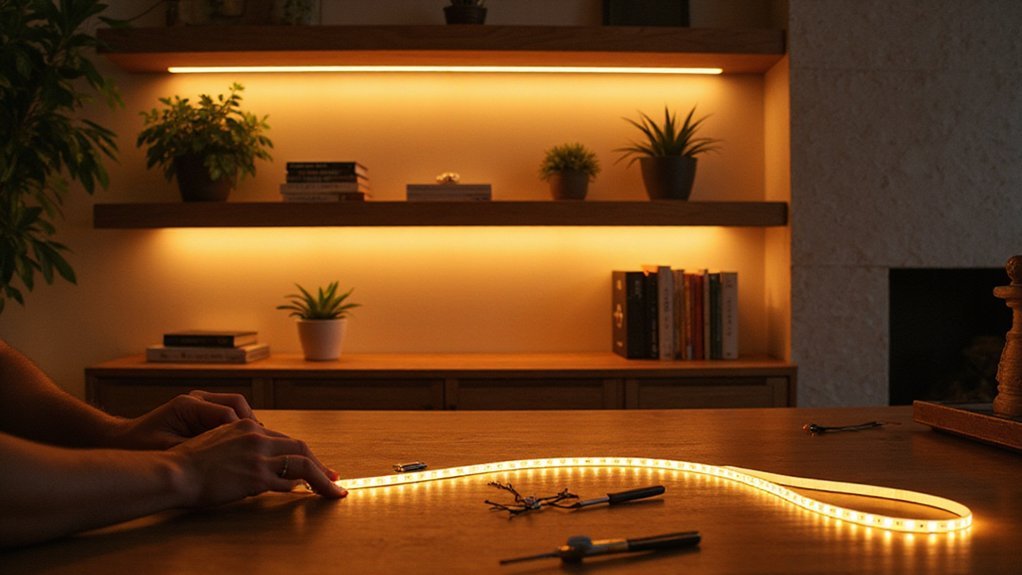Disclaimer: This content is for informational purposes only and does not replace professional medical advice, diagnosis, or treatment. Always consult a qualified healthcare provider before beginning any new exercise program.
You’ve likely experienced the impact of lighting on your mood and energy levels, but have you considered how precise LED technology can transform your living space? Circadian light strips offer a sophisticated solution for mimicking natural light cycles, potentially improving sleep quality and productivity. By understanding the science behind spectral tuning and strategic placement, you can create a personalized lighting environment that adapts to your daily rhythms. Intrigued by the potential of smart, budget-friendly illumination? Let’s explore how you can craft your own circadian lighting system.
Key Takeaways
- Select full-spectrum LED strips with high CRI ratings (90+) to mimic natural sunlight while maintaining an affordable budget.
- Use standard 12V DC power supplies and basic tools like wire strippers to minimize installation complexity and expenses.
- Prepare clean, smooth mounting surfaces and utilize adhesive backing with optional mounting clips for secure, cost-effective strip placement.
- Leverage programmable LED controllers that enable color temperature and intensity adjustments without requiring expensive specialized equipment.
- Experiment with DIY diffusion techniques like translucent materials to soften lighting and enhance circadian rhythm optimization economically.
Understanding Circadian Lighting Basics

The body’s internal clock—a delicate biological symphony—responds profoundly to light’s spectral characteristics. Circadian lighting leverages LED strips to replicate the natural light cycle, manipulating color temperature to optimize your physiological responses. During daylight hours, cooler light (5000-6500K) triggers heightened alertness and can boost productivity by up to 20%, while warmer tones (2700-3000K) signal the body to prepare for rest.
Strategic LED light strip installation allows precise control over your environment’s luminous landscape. By mimicking natural illumination patterns, you’ll support your biological rhythms, enhancing overall well-being. The key lies in understanding how specific light wavelengths influence your circadian rhythm, transforming simple illumination into a powerful tool for physiological optimization and performance enhancement.
Selecting the Right LED Strip for Your Space

How do you navigate the nuanced world of LED strip selection for circadian lighting? Start by prioritizing full-spectrum options like the Yuji SunWave, which deliver balanced light essential for physiological regulation. Focus on LED strips with CRI ratings above 90 to replicate natural sunlight’s quality. Consider your environment’s moisture levels when choosing between waterproof and non-waterproof adhesive variants; the 5630 non-waterproof variety offers superior brightness and efficiency for indoor applications.
Verify compatibility with your DC power supply, ensuring 12V specifications match the total wattage requirements of your planned installation. Calculate strip length against power supply capacity, preventing voltage drop and maintaining consistent light performance. Methodical selection guarantees ideal circadian lighting that supports your biological rhythms while providing precise, dynamic illumination across your space.
Gathering Essential Installation Materials

After meticulously selecting your ideal LED strip, assembling the right installation materials becomes your next systematic challenge. You’ll need a 12V DC power supply matched to your LED tape’s specifications, ensuring consistent voltage delivery. A wire stripper becomes essential for preparing connection points, allowing precise electrical connections. Verify the LED strip lights’ adhesive backing integrity, which facilitates secure mounting across various surfaces. Wire crimpers and crimp connectors offer modular flexibility during installation, enabling quick modifications and potential repositioning. Consider your specific installation environment when selecting between waterproof and non-waterproof light strips. A soldering iron and complementary wire provide backup connection methods. Budget-conscious installers can expect total material costs around $20, combining a 5-meter full-spectrum LED strip and compatible power supply for an efficient, cost-effective circadian lighting solution.
Mounting and Connecting Your Light Strips

Mounting LED light strips demands precision and strategic planning to guarantee peak performance and aesthetic appeal. You’ll want to start by preparing clean, smooth surfaces that’ll help strips adhere effectively. Consider using mounting clips at $1.99 per pack to secure your LED lights without relying solely on tape backing. When you connect the two power connections, verify polarity alignment to prevent functionality issues.
Opt for aluminum mounting channels for a professional look, which can accommodate strips up to 10mm and provide UV-protected light diffusion. If standard adhesive isn’t sufficient, use high-temperature double-sided tape to wire your strips securely. Make sure to test connections before final installation, ensuring each segment is properly mounted and powered for ideal circadian lighting performance.
Customizing Your Circadian Lighting Experience

With your LED strips securely in place, the next phase focuses on fine-tuning your circadian lighting system for maximum physiological benefit. You’ll want to one-up your setup by leveraging adjustable color temperature and smart controller features to enhance your environment.
| Feature | Customization Option |
|---|---|
| Color Temperature | RGBW spectrum control |
| Intensity | Programmable dimming |
| Positioning | Mounting heights adjustment |
| Diffusion | Frosted covers/reflective tape |
| Schedule | Time-based light changes |
LED power strips come with adhesive options, allowing you to customize placement precisely. Experiment with mounting heights to guarantee peak light exposure without causing eye strain. Utilize diffusion materials to soften harsh illumination, creating a more comfortable atmosphere. By strategically implementing these techniques, you’ll transform your space into a scientifically-tuned circadian lighting environment that supports your natural biological rhythms.
Frequently Asked Questions
Do I Need an Electrician to Install LED Strip Lights?
You’ll typically not need an electrician for low-voltage LED strip lights. Understand wiring basics, follow safety precautions, choose correct power sources, and use adhesive options carefully when DIY installing various LED strip types in your desired room placement.
How to Do the DIY Mode on LED Lights?
You’ll activate DIY mode on LED lights by selecting compatible RGB strips, connecting a suitable controller, matching power sources, and using remote controls to customize color options, light modes, and ambient lighting while following safety precautions.
What Is the Best Thing to Stick LED Strip Lights up With?
You’ll want extra strong double-sided tape for most surfaces, but mounting clips work best for downward applications. Consider aluminum channels for professional protection and heat management, ensuring your LED strips stay securely mounted and look seamless.
Do LED Lights Run up the Electric Bill?
LED lights won’t considerably run up your electric bill. Their energy efficiency, lower wattage, and smart controls minimize costs. By comparing usage habits and light intensity, you’ll see long-term savings and positive environmental impact with minimal electricity consumption.
Conclusion
You’ve transformed your space with a budget-friendly circadian lighting solution that’s both scientifically precise and elegantly simple. By carefully selecting full-spectrum LEDs and implementing strategic mounting techniques, you’ve crafted a lighting environment that synchronizes with your body’s natural rhythms. Your DIY project not only enhances aesthetic appeal but also optimizes your physiological well-being through intelligent illumination design.







